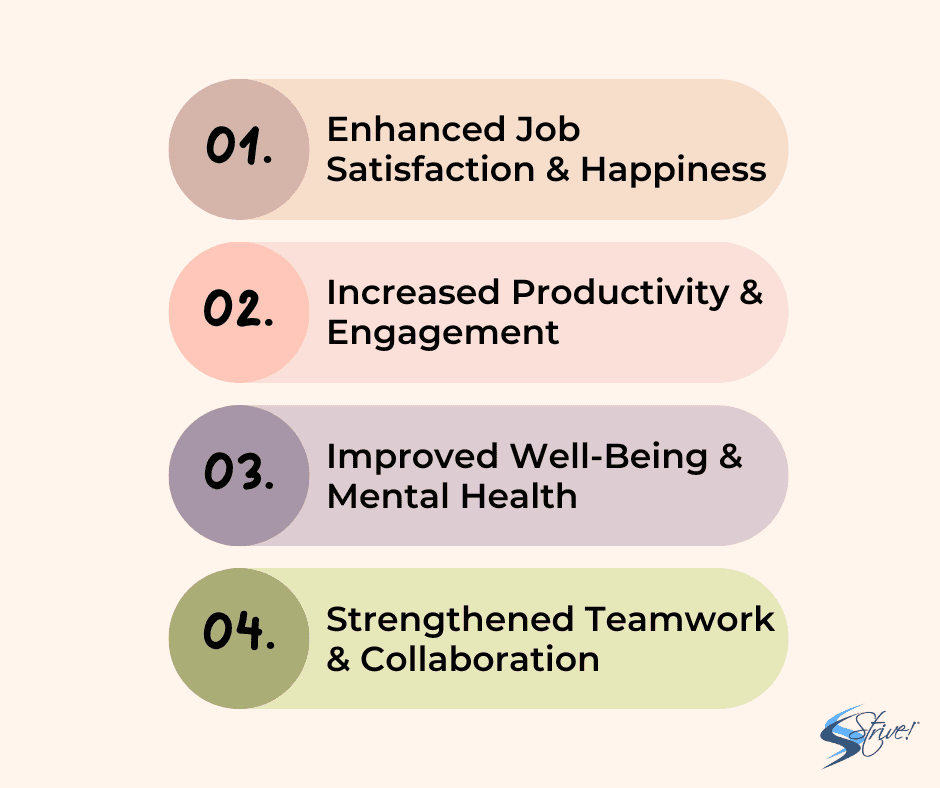The Power of Social Connections at Work
In a society where one-in-two adults report experiencing loneliness, the power of social connections at work has emerged as a compelling force driving employee engagement, productivity, and overall well-being. Business leaders recognize the critical role that building strong social connections plays in creating thriving organizations. Beyond surface-level interactions, these connections cultivate a sense of belonging, support collaboration, and enhance the holistic experience of your employees.
This article discusses the profound impact of social connections in the workplace, exploring benefits, strategies to build and nurture them, and innovative approaches for remote and hybrid work environments. Discover how investing in social connections transforms organizations and empowers individuals to do their best.
How Connecting with Others at Work is Essential for Well-Being
In this post:
1. Benefits of Social Connections at Work
a. Enhanced Job Satisfaction & Happiness
b. Increased Productivity & Engagement
c. Improved Well-Being & Mental Health
d. Strengthened Teamwork & Collaboration
2. Building Connections at Work
a. Encouraging Open Communication & Transparency
b. Promoting a Positive & Inclusive Work Culture
c. Organizing Team-Building Activities & Events
d. Facilitating Informal Interactions & Networking Opportunities
3. Leadership’s Role in Fostering Social Connection at Work
a. Leading by Example Through Approachability & Accessibility
b. Supporting Employee Initiatives & Social Connections
c. Recognizing & Rewarding Teamwork & Collaboration
4. Overcoming Challenges to Emotional Connection at Work
a. Remote Work & Virtual Team Dynamics
b. Generational & Cultural Differences
c. Addressing Conflicts & Fostering Constructive Relationships
d. Balancing Social Connections with Individual Productivity
Benefits of Social Connection at Work
Beyond casual conversations or pleasantries, genuine social connections at work are a game-changer for both individuals and organizations. These connections unlock a wealth of benefits and boost the overall well-being of your employees.
Enhanced Job Satisfaction & Happiness
Emotional ties at work create a support system that makes it a more fulfilling environment to be in. When employees feel a sense of belonging and relationship with colleagues, they are more likely to enjoy their work, feel satisfied in their role, and be invested in the organization’s mission.
Colleagues that choose to engage with one another get to share successes, celebrate achievements, and receive recognition and support from their peers. Having lunch or walking with a colleague to talk through an instance at work offers an outlet for stress and validation from a sense of understanding. Employees who have friends at work are more likely to feel satisfied and confident in their professional lives, leading to lower levels of burnout and feeling better equipped to handle challenges. When you’re committed to enabling friendships at work, you position your employees to feel valued and engaged.
Increased Productivity & Engagement
Employees that feel strongly connected to their colleagues are more productive and involved as they’re motivated to work together to achieve individual and company goals — and have some fun while doing it.
By building social connections at work, your employees establish a network of support, collaboration, and knowledge sharing. When individuals feel comfortable seeking help or guidance from their colleagues, it advances learning and personal development opportunities. This open exchange of ideas and resources enhances problem-solving capabilities, encourages innovative thinking, and improves performance. Your organization can tap into the collective potential of your workforce by promoting a culture of collaboration.
Improved Well-Being & Mental Health
One key benefit of social networks is the occasion for emotional support. Employees that have strong relationships with their colleagues feel comfortable confiding in them and asking for advice. This emotional support system helps alleviate stress, provides a sense of comfort, and enhances overall mental well-being. Sharing day-to-day challenges and successes with trusted colleagues reinforces their sense of belonging.
Social connections at work help combat feelings of isolation and loneliness, which have detrimental effects on mental health. When colleagues are encouraged to converse, laugh, or vent with one another, you create a natural buffer against workplace stressors and better mental health among your employees.
Strengthened Teamwork & Collaboration
Social interactions break down barriers and facilitate effective communication. Employees that feel comfortable with one another are more likely to openly share ideas, opinions, and feedback. This open communication promotes transparency, where everyone’s input is valued and respected. Strong social connections at work allow for active listening, constructive dialogue, and the exchange of diverse perspectives to improve decision-making and problem-solving.
Employees with established relationships are more inclined to leverage each other’s strengths and expertise. Collaboration becomes natural and fluid as individuals achieve synergistic outcomes that surpass what they could accomplish individually, and they develop a sense of accountability to their team. This shared commitment to success strengthens teamwork, positivity, and loyalty.

Building Connections at Work
To create and maintain emotional connections at work, you need a supportive workplace culture and strategies to spark meaningful relationships.
Encouraging Open Communication & Transparency
Encouraging open communication starts with establishing channels that promote the free flow of information. For example, consistent team meetings, one-on-one discussions, and digital communication platforms that allow for easy and instantaneous sharing of thoughts. Providing opportunities for employees to express their opinions and actively listening to their input fosters inclusivity and respect. It also creates space for colleagues to engage in purposeful, or even silly conversations that strengthen their bonds.
Leaders can cultivate transparency by including employees in the organization’s goals, decisions, processes, and changes. Understanding the context and rationale behind these initiatives builds a cohesive and informed workforce and develops a sense of trust and shared purpose. Leaders set the tone for a culture of open communication within the organization by sharing information, asking for feedback, and being willing to listen. This creates a climate where employees can easily share their thoughts, concerns, and ideas.
Promoting a Positive & Inclusive Work Culture
Creating a positive work culture involves developing an atmosphere of respect and empathy. This requires embracing diversity and valuing different backgrounds, experiences, and perspectives within the workforce. Embracing diversity not only enriches the workplace but also catalyzes the exchange of ideas and innovation. Celebrating and valuing differences inspires shared belonging and allows your employees to feel accepted and appreciated for who they are.
Prioritize respectful communication and encourage employees to treat one another with kindness and consideration. This includes actively listening to others, practicing empathy, and being mindful of how words and actions impact colleagues.
Discover how to keep employees happy.
Organizing Team-Building Activities & Events
Team-building activities can take various forms, ranging from adventures like hiking, volunteering, or escape rooms to wellness initiatives like fitness classes, healthy cooking demos, or stress management. These activities encourage collaboration, problem-solving, and effective communication among team members. Through shared experiences and challenges outside routine work, your employees have the chance to develop deeper connections, appreciate each other’s strengths, and learn how to work together.
Creating moments of fun and relaxation helps employees recharge and get to know each other on a more personal level. Choose activities and events that align with your team’s dynamics, incorporating opportunities for individuals to showcase unique skills and talents. Post-event, encourage team members to share insights, lessons learned, or memorable moments to help solidify the connections that were formed.
Social connections formed outside the traditional workspace are seamlessly integrated into day-to-day work practices, such as through shared goals or collaborative projects. Organizing team-building activities and events establish and reinforce colleagues’ relationships for a more cohesive and inspired workplace.
Facilitating Informal Interactions & Networking Opportunities
Encouraging informal interactions, such as coffee breaks, lunchtime gatherings, or walks, provides employees with opportunities to share interests and stories beyond work-related topics. Your organization can put policies in place to support employees in developing friendships, such as designated communal spaces, expected micro-breaks throughout the day, and even company celebrations for birthdays or achievements. Informal interactions expose employees to new perspectives, ideas, and opportunities to connect beyond work.
Additionally, organizations can organize events such as seminars, workshops, or conferences to help employees connect with colleagues from other departments and build relationships with industry peers. Networking opportunities can also stem from interest-based groups or clubs within the workplace.
Leadership’s Role in Fostering Social Connection at Work
Effective leadership plays a pivotal role in cultivating social connections within the workplace, setting the stage for a synergistic workforce. From promoting collaboration and openness to providing the necessary support and resources for relationship-building, leaders have key responsibilities in creating an interwoven work environment.
Leading by Example Through Approachability & Accessibility
Successful leadership goes beyond traditional notions of authority and decision-making. It extends to creating an environment where approachability and accessibility thrive. Leaders that exhibit these qualities set the stage for the power of social connections to flourish among their teams.
Approachable leaders break through hierarchical barriers with open communication, active listening, and guidance. They create a comfortable space for employees to express their ideas, ask questions, and share their perspectives without fear of judgment or retribution.
Leaders can demonstrate a willingness to connect with their teams on a deeper level simply by being accessible and practicing empathy. Being available to participate in team activities or for one-on-one discussions shows leadership’s commitment to employee growth and happiness. Impactful leaders inspire their teams to thrive on meaningful interactions.
Supporting Employee Initiatives & Social Connections
Taking a genuine interest in employee-driven initiatives gives leaders visibility into the diverse skills and perspectives of their population. Encourage team members to share creative ideas, suggestions, or solutions for cross-functional projects or social activities. Support opportunities where your employees can engage in conversation beyond work-related topics to form personal associations.
Team lunches, after-work events, coffee breaks, meditation or yoga classes, outdoor activities, etc. provide relaxed, casual settings for colleagues to build camaraderie and nurture their well-being. When employees are given time and space to develop stronger relationships with their peers, it leads to an overall more energized organization.
Recognizing & Rewarding Teamwork & Collaboration
It’s important for leaders to reinforce the value and importance of collective efforts to drive engagement through community. Recognizing and rewarding these efforts by expressing public appreciation or gratitude boosts morale and sets a positive example for others to follow.
Whether it’s during team meetings, company-wide announcements, or dedicated recognition events, publicly recognize individuals and teams who have demonstrated outstanding collaboration. Highlight specific examples of how their combined efforts have contributed to the success of projects or organizational goals. In addition to recognition, offering tangible rewards can be a powerful way to incentivize and reinforce teamwork and unity.
Consider implementing a rewards and recognition program that acknowledges and celebrates collaborative achievements. This can include bonuses, special incentives, or team-based rewards that recognize exceptional group efforts and results. Such rewards not only recognize individual contributions but also emphasize the significance of collective accomplishments, supporting a culture of collaboration throughout the organization.
Overcoming Challenges to Emotional Connection at Work
While building strong connections among colleagues is essential for a supportive and engaging work environment, there are various challenges that can hinder the development of these connections. While it can be difficult to navigate these obstacles, there are proactive strategies you can use to overcome them.
Remote Work & Virtual Team Dynamics
With remote work, team members don’t benefit from the face-to-face interactions or spontaneous conversations that in-office employees experience daily. Collaborative tools, video conferences, and communication channels are vital for remote workforces looking to develop stronger bonds among colleagues. Just like long-distance friendships, it’s important to carve out time for virtual coffee breaks, happy hours, or online games to facilitate non-work-related conversations.
Encourage your employees to turn their cameras on during video conferences to humanize virtual interactions and promote collaboration through shared documents and collective problem-solving. Managers should regularly conduct one-on-ones with employees to check in on life in and outside work and leverage virtual platforms to acknowledge and celebrate achievements.
Generational & Cultural Differences
It’s natural for generational and cultural differences to exist in the workplace. Organizations can leverage active listening and cultural awareness training to increase understanding and respect for diverse perspectives. Provide opportunities for employees to share their culture by promoting cultural events or celebrations.
Support cross-generational mentorship programs for knowledge sharing and form diverse teams to showcase varying talents and to build trust. Use these strategies to help teams embrace variety and build an inclusive and emotionally connected workplace that harnesses the strengths of each employee.
Addressing Conflicts & Fostering Constructive Relationships
Conflicts are inevitable in the workplace, but it’s how they are handled that impacts relationships among team members. To build constructive relationships, encourage open and respectful communication, provide conflict resolution training, and establish clear expectations. Organizations can also incorporate stress management classes such as mindfulness meditation, yoga, or breathwork to help employees build resilience and better navigate conflict. Leaders can set expectations by cultivating growth-oriented relationships, building a culture of feedback and learning, and participating in team-building activities.
Balancing Social Connections with Individual Productivity
To achieve a healthy balance of social interactions and individual productivity, establish expectations and designate social spaces where your employees can benefit from organic run-ins away from their desks or office spaces. Encourage collaborative projects in communal spaces to accommodate social engagements and focused, team-based work. Promote breaks where colleagues can walk, stretch, or participate in a wellness initiative together, then return to their work sharp and refreshed. By emphasizing collaboration, teamwork, and burnout prevention, you can nurture employee well-being while maintaining high levels of productivity.



